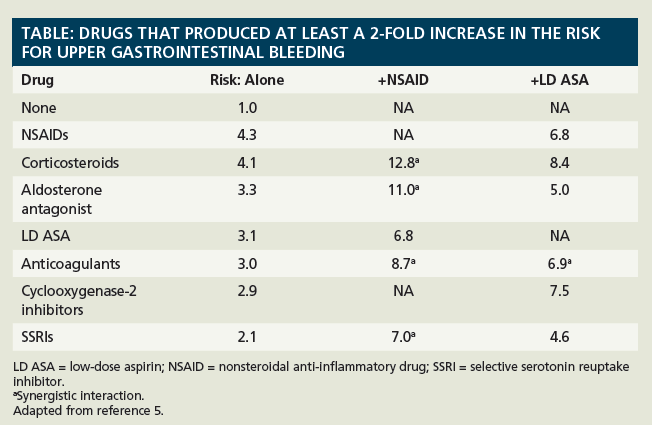Publication
Article
Pharmacy Times
Gastrointestinal Bleeding Due to Drug-Drug Interactions
The risk for upper gastrointestinal bleeding associated with the use of nonsteroidal anti-inflammatory drugs, corticosteroids, selective serotonin reuptake inhibitors, and antiplatelet drugs is well known.
The risk for upper gastrointestinal (UGI) bleeding associated with the use of nonsteroidal anti-inflammatory drugs (NSAIDs), corticosteroids, selective serotonin reuptake inhibitors (SSRIs), and antiplatelet drugs is well known.1-4 While various articles have addressed the potential risk for UGI bleeding when combinations of these agents are used, a recent study examined the risks associated with multiple pairs of these agents in the same population database.5
The authors analyzed data from 7 European databases that identified nearly 115,000 patients with UGI bleeding, including more than 900,000 person-years of follow-up. An important feature of this study was the use of a self-controlled case series design. This enables the estimation of the incidence of UGI bleeding during exposed and nonexposed periods for each case. Potential confounding factors that would be present in a case-control study (eg, age, diseases, other drugs, genetics) are eliminated because each patient acts as his or her own control. Drug dose and frequency were not available for analysis.

The Table shows the results of evaluated drugs that produced at least a 2-fold increase in the risk for UGI bleeding. When patients are receiving none of the drugs considered to increase the risk for UGI bleeding, the risk is set at 1.0. For the drugs in the Table, the risk for UGI bleeding increased from 2-fold to more than 4-fold during single-drug exposure (Alone). The estimates of risk are similar to those reported for single-drug exposure in previous studies. If the drugs were administered in combination, the risk would be expected to be additive, more than additive (synergistic), or less than additive (antagonistic). When paired with NSAIDs, most of the drugs showed synergistic effects on the risk for UGI bleeding. Low-dose aspirin (LD ASA) showed synergism only with anticoagulants, but appeared to have additive risk when used with most of the other drugs. NSAIDs plus corticosteroids demonstrated the greatest risk for UGI bleeding.
Most of these drugs are ulcerogenic and/ or inhibit platelet activity. Corticosteroids are considered to be ulcerogenic at high doses, but even lower doses are likely to delay the healing of ulcers, leading to a greater risk for bleeding. The mechanism for aldosterone antagonist—induced UGI bleeding is unclear. It has been suggested that spironolactone inhibits the formation of fibrous tissue as a result of its binding to mineralocorticosteroid receptors. A similar risk for UGI bleeding (2.7) has been noted by others, with the risk increasing to 5.4 with doses of 100 mg.6
In general, LD ASA is associated with a lower risk for UGI bleeding compared with NSAIDs when used alone or combined with other drugs. LD ASA was the most commonly used drug in Masclee and colleagues’ study. It is important to consider the widespread use of LD ASA and the large number of patients at risk. While no data were presented, several SSRIs (fluoxetine, fluvoxamine, nefazodone) inhibit CYP3A4, which is responsible for the metabolism of corticosteroids. Fluoxetine and fluvoxamine inhibit CYP2C9, the enzyme that metabolizes NSAIDs and warfarin. Thus, there is the possibility of a pharmacokinetic and a pharmacodynamic interaction with some of the drug pairs. The authors note that the risk for bleeding was greater in patients older than 60 years.
This study clearly demonstrates that multiple common drug combinations can increase the risk for UGI bleeding. Consider the risk associated with LD ASA use, particularly in elderly patients or those taking other drugs that can increase the risk for UGI bleeding. Patients receiving these combinations should be counseled to watch for signs of UGI bleeding. The administration of acid suppressants should be considered in these patients, particularly if the patient has a history of GI ulceration or bleeding.
Drs. Horn and Hansten are both professors of pharmacy at the University of Washington School of Pharmacy. For an electronic version of this article, including references, if any, visit www.hanstenandhorn.com.
References
1. Rooney PJ, Hunt RH. The risk of upper gastrointestinal haemorrhage during steroidal and non-steroidal anti-inflammatory therapy. Baillieres Clin Rheumatol. 1990;4(2):207-217.
2. Jiang HY, Chen HZ, Hu XJ, et al. Use of selective serotonin reuptake inhibitors and risk of upper gastrointestinal bleeding: a systematic review and meta-analysis. Clin Gastroenterol Hepatol. 2015;13:42-50.
3. Coleman CI, Sobieraj DM, Winkler S, et al. Effect of pharmacological therapies for stroke prevention on major gastrointestinal bleeding in patients with atrial fibrillation. Int J Clin Pract. 2012;66:53-63.
4. Dalton SO, Johansen C, Mellemkjaer L, et al. Use of selective serotonin reuptake inhibitors and risk of upper gastrointestinal tract bleeding. Arch Intern Med. 2003;163:59-64.
5. Masclee GMC, Valkhjoff VE, Coloma P, et al. Risk of upper gastrointestinal bleeding from different drug combinations. Gastroenterology. 2014;147:784-792.
6. Gulmez SE, Lassen At, Aalykke C, et al. Spironolactone use and the risk of upper gastrointestinal bleeding: a population-based case-control study. Br J Clin Pharmacol. 2008;66:294-299.







